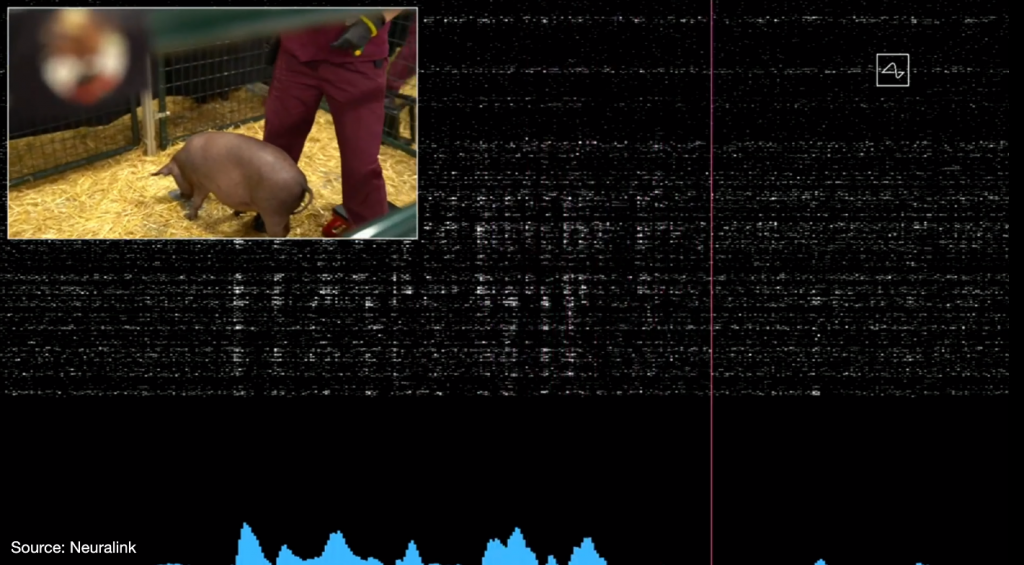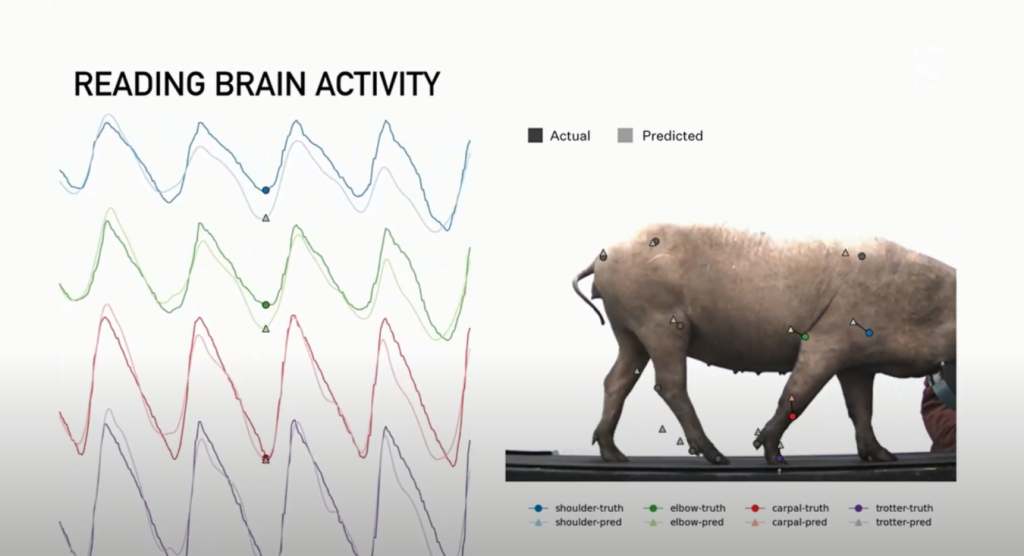
The medical and health industries have seen amazing progress over the past few decades thanks to technology improvements. As good as modern med-tech is, a large part of our answer to human issues remains in the treatment of symptoms (usually with medication), rather than actually solving the core issue.
Today we got an update from Neuralink, one of many Elon Musk’s projects to change the world. Just when you thought his goals of transitioning the world to sustainable transport (and energy), making our species inter-planetary (Mars) was enough, here comes Neuralink which could actually change more lives than the rest of Musk’s projects combined.
It’s been 12 months since we had an update from the team at Neuralink and today we got to see the progress made in the last year.
The Neuralink device is currently known as LINK V0.9 and is the size of a 10 cent coin at 23mm in diameter, while also being 8mm deep, which is conveniently right around the thickness of the skull.
The device is made up of a communication surface (this bottom layer connect tiny wires that attach to parts of your brain that read and even write electrical signals. Next, we have a custom developed circuit board that includes things like analog to digital converters to make the signal usable, as well as Bluetooth LE to communicate with your phone (or other Neuralinks). The device also features a 6-axis inertial measurement unit (IMU), as well as sensors that detect temperature, pressure and more.
On top of this, we also have a battery with an inductive coil to enable charging which at this stage would be done each night. Finally, we have a cap or cover that protect the whole device from the body which is a fairly harsh environment for electronics to live.
Such is the precision required by Neuralink, that engineers are building specialised robots to perform the operation to insert the device, as the scale is far beyond human capability.


These robots would cut a hole in the skull, attach the electrode to your brain with amazing precision, avoiding any arteries that would cause blood loss.
The device would then be inserted in-place of the section of the skull, sitting flush with the surface of your head and would not be seen by others. The robot would then seal it in place with glue, which sounds like an industrial solution to a very human challenge, but is actually already used in the health industry widely.
This fact you can’t see if someone has a Neuralink is a big deal, its in stark contrast to many of our current technologies like the cochlear hearing implant that sits over the ear or regular reading glasses that help augment our vision.
This takes us to what Neuralink could actually solve. Musk showed a very ambitious slide that will no doubt get many very excited by the possibilities. Major physiological health issues like Memory Loss, Hearing Loss, Blindness, Paralysis, Extreme Pain, Seizures, Strokes and Brain Damage could all be overcome using this technology.
Then we layer in some mental health issues like Depression, Anxiety and Addiction, things that many in our community struggle with and as a society we spend Billions trying to support people with, but don’t actually have many solutions.
So now for the progress update. Today’s demonstration included a series of pigs which are considered to be a fairly good proxy for humans, and successful animal trials are regularly the pathway to human trials.
During the 3 little pigs demo, we met Dorothy, a pig which had received the implant, then had it removed. The happy healthy pig demonstrated that the operation is in fact reversible. This is important for a few reasons. If your body rejected the implant, if you decided you didn’t want it, or in years to come as the technology improves, you decide you want to upgrade.


Gertrude was the star of the show, albeit a little shy. This pig has successfully had a Neuralink implanted for 2 months. The LINK was connected neurons in Gertrude’s snout, so as she moved about and ate, we were able to see (and hear) pulses of energy.
What’s incredible is the Nerualink team are able to put the Pig on a treadmill and watch its brain activity. They can predict with incredible accuracy, the movement of each on of its limbs. It’s probably not surprising that we know the brain controls the body, but what is impressive is the level of accuracy Neuralink has been able to decode from the brain.


It’s easy to see where this is going. If Neuralink can read the signals sent from the brain, it’s possible that it could also take a human’s thought and turn that into action. In the case of someone who’s paralyzed, they’d have a second device below the impacted part of their spine that would receive the messages sent by Neuralink, essentially creating a wireless communication channel to replace the physically severed spinal cord.
While we’re years away from this, it’s plausible that this could be used to get wheelchair-bound people walking again. That would be truly life changing.
Obviously there’s a lot of medical safety concerns that are raised by the prospect of working with people’s brains, so Neuralink is working with the Food and Drug Administration (FDA) of the United States Department of Health and Human Services.
During the presentation, Musk announced they had received an FDA Breakthrough Device designation in July. This program was created with the explicit purpose of speeding up the development and assessment of devices that promise a more effective treatment or diagnosis for life-threatening or irreversibly debilitating conditions.
Neuralink’s next milestone is to prepare for the first human implantation (soon), which they will need further approvals and safety testing. Given the progress made in the past year and the wildly talented people we seen provide answers during the Q&A section of the livestream today, I have no doubt this team will get this done.
Today’s information was really eye-opening to the public, about just what Neuralink is up to, but it seemed overall the main motivation was a recruitment drive. There are clearly still some really hard problems to solve and having big bold ambitions to benefit humanity, will certainly inspire some to join the team.
This med-tech revolution won’t come easily with everything from building robots with staggering accuracy and repeatability, to the hardware devices and software that brings it all together, this is a massive challenge. I also wouldn’t be surprised to see additional funding come to the project.
Whatever you think of Elon, he’s not short of a dollar, so the positive thing from all of this, is his goal is to make it accessible. He mentioned the initial cost would be high, but is expected to come down dramatically over time. It is expected the price to get a Neuralink would be comparable to getting lasik surgery on your eyes, so a few thousand dollars.
The expectation is also that this procedure could be done and you walk out of the hospital the same day. That’s kind of wild. The LINK device would connect to your phone, so presumably, you’ll have some decisions to make about what you need it to help with. Then if you want it to do more, is that an in-app purchase?
Probably the craziest concept discussed today was certainly the ability to save and replay memories. He was also asked about some more fun interactions that would be possible, like being able to Summon your Tesla using just your brain (telepathically).
Without hesitation, Elon replied, “Definitely, of course’. With this implant, just by thinking, you can output words and type, so when you understand that, it’s easy to see why Musk was so confident in this response, it’d be a fairly simple task to convert these words to commands and send to the car (assuming pre-authorisation to do so).
Discussions like this, about less health-related and more convenience-related are likely to happen all over the world, with Neuralink creates a serious number of possibilities that we’d just never thought possible before.
I can see this becoming a platform (secure of course) where medical experts and developers can work together to leverage the hardware of Neuralink and improve people’s lives.
Assuming it passes the health checks and the human body can live with it, it’s conceivable that some perfectly healthy people will get one to enhance or augment their lives, however they are likely at the back of the line, behind millions of people who actually need it, not just want it.
If you want to watch the highlights from the presentation, check out the video below.
